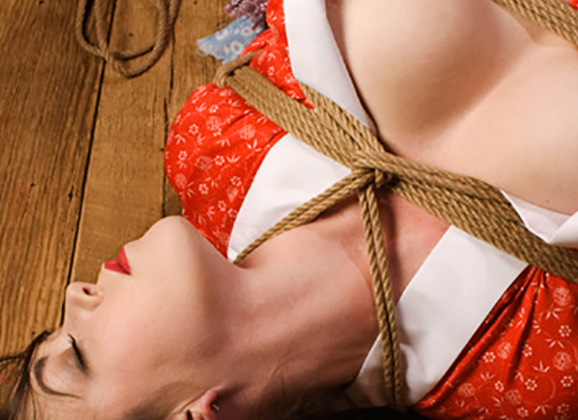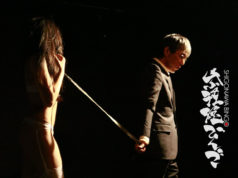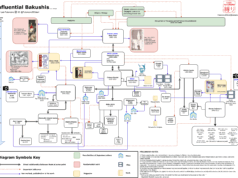By Clover © 2013 (Reprinted with Permission)
Introduction
This is a set of guidelines for those who are new to rope bondage, and those who want information on bondage safety from the rope bottoms perspective. With the increase of bondage riggers who are not aware of safety, it is important for a resource such as this, to provide rope bottoms with information that you will need to make informed choices with your rope bondage experience.
One of the most important points to remember about rope bondage, besides having fun, is there is always a risk. There are risks attached to any bondage scenario even with the best bondage rigger. There is ALWAYS a risk. You can minimize this risk be being self-aware, informed and working with a rigger who is skilled and risk aware. You will significantly reduce the risks of bondage but you will not eliminate the risk entirely. It is very important to understand and remember that all bondage has an associated risk.
This article is a general guide; it is by no means suited to every rope bondage situation and every body type. It is important to remember that every person’s body is different, what is correct for you, might be dangerous for another person. It is the riggers responsibility to ensure what they are doing, is right for your fitness level and body type but for this to happen, it is up to you to communicate. Communication is vital to reduce the risk involved with rope bondage. It is your responsibility to communicate and give feedback before, during and after bondage.
Sometimes skilled, experienced and risk aware riggers can go against these guidelines with your risk aware consent, if approached with caution, keeping the risks and safety in mind. However, a rigger must know the rules that they are breaking and why these rules are there to begin with, before they decide to break them. Don’t be afraid to question your rigger at any point.
Responsibility
You are responsible for you. You are responsible for who you allow to tie you. It is up to you to know the risks involved in what you are about to do. Educate yourself. Be aware. Learn about your own anatomy and personal vulnerabilities. It is your responsibility to disclose health problems to your rigger or inform them of anything you think they should be aware of.
The Bondage Rigger
Ideally, your rigger should, be good at communicating, posses good knowledge of anatomy, be aware of potential risks and how to act in an emergency. Your rigger should demonstrate good skill and experience, with an openness to learn and expand this skill.
How to measure a good rigger?
This is a difficult question, with no exact answer. Here are some suggestions to consider when negotiating bondage with a potential rigger.
What bondage experience have they had?
Years of experience does not always equate to years of skilled bondage. It could mean that they have been performing unnecessary risky bondage for many years and they have been very lucky. When taken into account with other factors, their level of experience can be a good indicator.
How confident do they feel about their rope bondage skills?
There are some riggers who feel very confident of their rope bondage skills even if they are limited. Even if the rigger boasts years of experience, drops names and talks about how many people they have tied, please check for references; do not just take their word for it. Do not to confuse an attitude of arrogance with one of self-assured confidence.
Do they have any references?
It is good practice to check references if you are being tied by this person for the first time. Ask around to see if you can obtain any references from people the rigger has tied up before. Always get more than one reference, including (if possible) a reference from someone you consider to be an experienced rope bottom or top. If possible, get a reference from any people who have refused to allow the rigger to tie them to find out why they chose to refuse. Do not allow anyone to tell you that you are doing the wrong thing by seeking this information. It is for your safety.
Does the rigger know common vulnerable or problematic areas when placing rope and sites of common injury?
When asking this question, it is important for you to be familiar with the correct answer, I would recommend finding out as much as you can about bondage and anatomy. At this point, it can be good to discuss with your rigger any personal vulnerable areas you are aware of.
Does the rigger have a suitable means to cut the rope in an emergency?
For instance EMT Shears or rescue hooks etc. It can be useful to have your own pair of EMT Shears, this way you can give them to your rigger and know they have a reliable means to cut the rope in an emergency. Although, if they do not have a means to cut the rope, this can be a good way of establishing they are not responsible enough to tie you.
Anatomy
By having a basic understanding of human anatomy and good knowledge of the common vulnerable locations, you will ultimately make your bondage experience safer and more enjoyable.
If nerves are injured you can lose sensation and the ability to move a part of your body. Clearly, it is important to ensure that your nerves are not damaged. Unfortunately, this is one of the most common injuries with rope bondage, especially in suspension.
Nerves and Circulation Concerns
Tingles or ‘pins and needles’ in your hands or any body part is you body warning you something is wrong. The two most common causes of this prickly tingle feeling is loss of circulation and nerve injury.
There are a few symptoms which can tell us what the problem is, these symptoms may not be present every time but when they are, it can be very helpful.
Nerve injury is unique because in most cases only part of the hand will be numb or present with a prickly ‘pins and needles’ feeling. A characteristic of nerve problem is that this feeling will present in only part of the hand.
There are some measures to check for nerve problems;
• Your rigger can ask you to squeeze their hand; this demonstrates the strength in your hand.
• Your rigger can place their hand on the back of yours and ask you to push back against them. This is important because with nerve problems you might have no problems squeezing and still have a nerve problem, this test will help determine if a nerve problem has occurred.
• Your rigger can gently run their nails along the back of your hand, this is to test for dull/loss of sensation.
If you have any of these symptoms for longer than 2 hours, go to a doctor or A&E.
Circulation problems in rope bondage are caused by preventing blood flowing to/from a limb or body part. It is not as urgent as nerve problems but it is still a warning and should not be ignored. The more practice you have in rope the more body aware you will become and better to judge how urgent it is.
Loss of circulation can be identified by skin colour changing, for example, blue or purple. This colour change is very personal, some bottoms will turn colour very quickly and remain comfortable in the rope, while others will need to be untied. Communication at this point is vital.
Another common symptom of a circulation problem is your entire hand, arm, leg or bound body part may go numb or tingle.
Relieving circulation problems can be helped by the following:
• Having your rigger running their fingers under the wraps of rope to even the tension and adjust the rope.
• If your arms are tied in a box position, swapping the position of your forearms.
• Flexing your muscles will help to circulate your blood; clenching and unclenching your hands can help alleviate tingling.
• When untied the symptoms should disappear immediately.
Circulation problems do not mean the nerves are suffering; the main concern with circulation problems is the symptoms can mask symptoms of nerve problems. If your whole hand is numb and tingling from loss of circulation, you now have no way to know if part of your hand is tingling from nerve injury.
My advice to anyone who is unsure would be, if you have tingles in any body part while in bondage, it is time to be untied. You can always be tied up again later.
The danger with nerve injury is that it happens instantly, by the time you notice a problem the damage is done. In contrast, with loss of circulation, you will get symptoms long before there is any danger. This is why it is important to communicate to your rigger when something does not feel right; if they act immediately it can reduce or eliminate the damage. Nerve damage can be cumulative and build up over time with repeated episodes of risky bondage.
Wrists
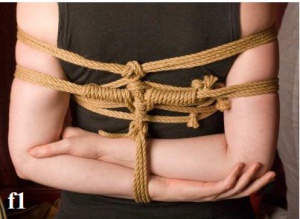 In a ‘box tie’ fig 1 the wrists are vulnerable areas, particularly the inside of the wrist and the valley between the hand and wrist bone, as nerves and veins are more exposed here. As you gain more experience, you will find hand and arm positioning that suits you best.
In a ‘box tie’ fig 1 the wrists are vulnerable areas, particularly the inside of the wrist and the valley between the hand and wrist bone, as nerves and veins are more exposed here. As you gain more experience, you will find hand and arm positioning that suits you best.
If you are inexperienced I would recommend you have your wrists facing each other to protect this vulnerable area on the inside of the wrist. If the wrists are facing each other the rope will be tied around the outside of the wrists to protect the vulnerable area inside the wrist.
Rope should not be tied with a knot that may tighten around the wrists. You should have space between the rope and your wrists for movement so that you can ‘swap’ your hands over if necessary for comfort during bondage.
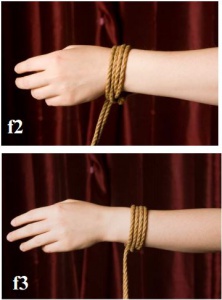 RISKY rope placement (fig 2). The rope is close to the hand, over the wrist joint and in the groove of the wrist. This is unsafe because the radial and ulnar nerves are vulnerable in this groove. This placement is one of the most common causes of a loss of sensation in the fingers (a handcuff neuropathy) with all types of bondage.
RISKY rope placement (fig 2). The rope is close to the hand, over the wrist joint and in the groove of the wrist. This is unsafe because the radial and ulnar nerves are vulnerable in this groove. This placement is one of the most common causes of a loss of sensation in the fingers (a handcuff neuropathy) with all types of bondage.
REDUCED RISK rope placement (fig 3). The rope is further away from the hand, away from the vulnerable groove in the wrist. The rope is on the arm side of the wrist joint, this placement is far less likely to cause nerve problems.
Upper Arms
The radial nerve provides sensation and muscle control for parts of the arm. If it is damaged you may lose the movement or sensation in parts of the arm.
It can be difficult to determine the exact point where the radial nerve is vulnerable on a person. The radial nerve is generally most vulnerable in the area between the deltoid and triceps muscles. The rope should be placed in this area with caution and sympathy to the particular physiology of the bottom. It is up to you to give feedback to your rigger and be aware of how your body is reacting to the rope in this area. Remember symptoms of radial nerve problems often present in the hands.
If the wraps of a box tie do not feel right, or you feel nerve problems immediately, adjusting the wraps slightly can make a huge difference. Feedback and communication is important when finding the right rope placement for you.
Armpits
There is a cluster of nerves in the armpit (brachial plexus), including the Radial, Median, Ulner and Axillary nerves.
Wraps, kanuki and rope joints should not dig into the armpits.
In some types of chest harness the arms are not tied into the bondage no rope should put pressure into the armpit. There must be no knots, bulges or joins in
the rope in the armpits because this will increase pressure and risk of nerve damage.
Recommendation:
If you are a model, working with a photographer for a bondage shoot, it can be a good idea to ensure that a professional rigger is present by either hiring one yourself or asking the photographer to do so. A professional rigger should ensure that rope bondage is safe, secure and beautiful to the model and photographer’s requirements, allowing the photographer to concentrate on producing the desired images.
Improving Your Bondage Experience:
Remember that during play safety comes before D/s protocol.
Remember that during a photo shoot safety comes before doing your job as a model.
Communication
It is important to inform your rigger of health problems before rope bondage:
• Internal health problems you may have, including breathing, pacemaker, heart, circulation and nerve damage problems.
• Mobility problems.
• Mental or emotional problems that are significant to your rope experience.
It is important to communicate during bondage:
• How the bondage feels. Sometimes even a small adjustment can radically change how the bondage feels and make the tie safer.
• Any feeling of tingly fingers whilst in bondage which will give your rigger time to react to the problem. The sooner you make them aware of any problems the better the outcome will be.
It can be helpful to give feedback afterwards.
• Reflecting on your experience, how you felt emotionally and physically,can not only help you grow as a bottom but you will also aid your rigger improve their own skill and awareness.
Stress
Rope bondage will cause a varying degree of stress on the body. This is particularly true of most full and partial suspensions and even some floor bondage. It is helpful to make sure that you are as fit and healthy as possible to help you to withstand this physical stress.
A physically fit person will be able to withstand bondage for longer than an unfit person. They will recover from any bruising rapidly and will find that their breathing is not as badly restricted. In the event of nerve injury, the fitter you are the quicker you will heal.
Bondage can be emotionally stressful so it is important to ensure that you are mentally prepared for bondage and in the right state of mind to be placed in bondage. Most people find it helpful to be calm and relaxed but alert and present in the moment for bondage to take place.
Stretching
Increased flexibility cannot be achieved instantly but must be worked on consistently and regularly to be maintained and enhanced. You should move around and stretch gently before bondage to warm your muscles. If you know what position you will be bound into, you can concentrate on the muscles that will
be put under strain in the position.
Stretching while in bondage and flexing your muscles will help circulate the blood around your body. Stretching will prevent tingling and help prevent muscle ache. If your fingers begin to feel tingly tell your rigger immediately. Clenching and unclenching your fist can help with tingly fingers.
Temperature
If you are cold you will not be able to withstand bondage for as long as you would if you were warm because the fluid in your joints will be thicker and your muscles will be colder and less flexible as a result. Try to ensure the room is warm enough, particularly if you will be naked.
If you are being tied up outdoors or in a cold space, wear something warm between ties and drink plenty of warm fluids. It is best to avoid extreme temperatures.
Food
Do not skip any meals before bondage. Have snacks and a sugary drink to hand for between ties or after bondage. Being in bondage might appear static but holding poise in bondage uses a lot of energy and can be quite demanding on your body, dynamic transitions can be even more exerting. Make sure you drink plenty of water.
Coming Undone
When you are being untied, it can be tempting to slouch and cross your forearms into a scissor position. This can be a natural reaction to the end of a rope bondage experience. There are some problems caused by this action.
First, it can make it difficult for your rigger to untie you and second, by scissoring your hands, you put yourself at risk of nerve damage or loss of circulation as the rope will tighten around your forearms.
As with any exercise, stretching afterwards is very effective, aids recovery and prevents injury. Gentle stretching and slow movement after bondage is recommended, sudden movements can be damaging and risky to your muscles and joints.
For PDF versions and translations of this guide, please visit: Rope Topia

